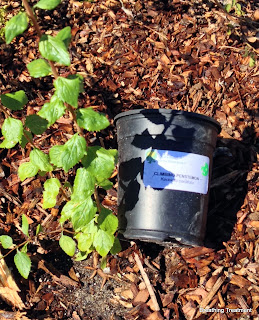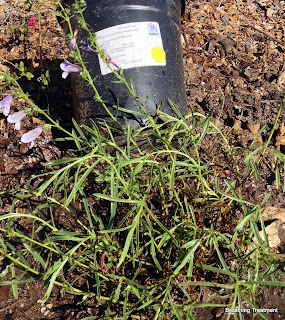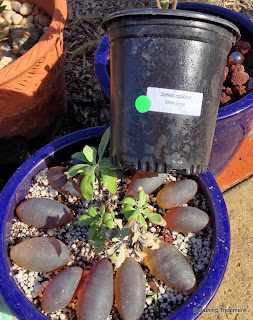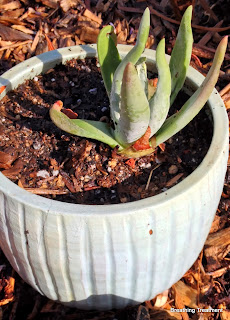I mentioned just the other day about how I shopped online at Annie's Annuals for some fall plantings, but additional guilty pleasures of local plant sales weren't far away and offered other tantalizing new plants as well as old favorites to augment what's working.
I couldn't stay away from the SCCNPS plant sale where my tastes ran to really local plants and then less than a week later I made a trip to the Rancho Santa Ana Botanic Garden nursery, Grow Native, in Westwood. I did manage to exert enough self-control to avoid the Payne Foundation's plant sale this year. Nonetheless, all told I had about 20 new plants. My prior tendency has been to get them in the ground a bit at a time, but this year I did them all in one fell swoop.
How did I manage to prep and plant that many new plants? The magic of government furloughs came into play giving me ample time to enjoy a curious mental state half way between unemployment and retirement. I guess there's at least one thing for which I can thank the radical edge of the Republican party.
I've decided to keep track of what I've planted using the simplest method possible: I just take a photo of the installed plant next to its empty container. Not the most aesthetic, but definitely the easiest way for me to maintain my records. This is a long post, so click to read more at your peril.
This front entry pot had a happy California Bay in it, but that's not an extremely interesting plant choice for a grand entryway statement. Other than the Bay, I've had poor luck in this location since it gets nearly full shade in winter and bright full sun in summer. After much hemming and hawing I'm going with the combination of Garya elliptica 'Evie' (Evie silktassle) and Adenostoma fasciculatum var. prostratum 'San Nicholas' (San Nicholas dwarf chamise). Normally, I'll forget these names in a month of two, or perhaps a year. Not anymore:
I later decided that removing two of the three hardscape features from this pot (leaving only the rock with the prominent shellfish holes) looked better. I hope the Adenostoma will tumble over the edge of the pot and the Garrya will grow with an interesting structure in addition to the catkins that it is famous for (the silk tassles of its common name). It's looking a bit ragged right now because I picked it from the discount stacks at RSABG Grow Native nursery (at significant discount, of course). Colleen at Grow Native says that with enough water it will be OK in the summer, so I'll need to keep on top of that and do my best to encourage root development now.
I need some shade and vertical contrast in my exposed back yard and I've struggled for a while about the best plan of attack to address these needs. Chiolpsis linearis 'Purple Splendour' (Purple Splendour Desert willow) should go part way towards meeting my needs by making a spot of shade in summer, a place for birds to perch, and leaf mulch in winter. I've sited it so that it will work with the view that I wish to preserve. Hummingbirds are going to love the flowers on this shrub / small tree. Las Pilitas has it on a top list for Los Angeles area gardens (even though it is a Riverside County native) and I think it will be well-suited to mine.
I'm trying more container plants these days, but I don't want to worry about their maintenance too much so I'm trying to choose tough plants that can take neglect. These seem to suit the requirements: Another Adenostoma and a couple Dudleya are planted in upright drain pipes here. There's plenty more drain pipe at my parent's house if this works. I used a commercially available "desert" planting mix for the Dudleya and a mix of my own preparation for the Adenostoma. Dudlyea traskiae (Santa Barbara Liveforever) lower right, Dudlyea virens (Bright green Dudleya) lower left.
I often mark my new plants with piles of rock or sticks that I place nearby because they are small at first and often overlooked while establishing themselves. The sticks are just a temporary visual reminder that I have a small new plant nearby and the rocks are piled on the south side are intended to give a bit of extra protection from the sun.
Here's a closeup of the Festuca californica (California Fescue). It ought to grow into a clump that is 12-24" across.
Elsewhere in the pool area I've planted Keckiella cordifolia (Climbing penstemon, heart leaved penstemon) where it can go up and through a Lantana shrub. I'm hoping that the Lantana will hide the summer deciduous Keckiella. Of course the Lantana is not native to California but the stout shrub form of it is one that I don't often see in commercial / city planting and I do like its blooms, plus it's well-sited, so it stays for the foreseeable future.
Penstemon 'Margarita BOP' has done pretty well on raised mounds of well draining soil in the pool fill area, so I put in another. BOP = Bottom of Porch, the location where this hybrid first grew. Las Pilitas, who introduced the plant, notes, "This plant will 'key' to P. heterophyllus but we believe it is a second generation hybrid with P. laetus."
Verbena lasiostachys (Western Vervain, California Vervain) also went into the experimental pool fill area. Las Pilitas doesn't seem to like this plant very much noting, "California Vervain is an aggressive perennial that is weedy in gardens. In the wild it is a pioneer species... ...Native to most of California to Oregon. It should be considered when hydroseeding or planting for erosion control or if you really need butterflies in your garden." But it seems just the type of plant that I need for this area which has defeated many other attempts to grow other natives.
Below, it's shown with my favorite gardening tool of the week and a small piece of rock that is piled on the south side.
I purchased two of these locally native Astragalus trichopodus (Rattlepods) from the SCCNPS plant sale. One went in this pot where I hope it will have an elegant form and the other went on my hillside. I found what appears to be an ancient one of these in Lunada Canyon - the trunk was several inches in diameter and it grew out of a rocky canyon sidewall that couldn't have offered nearly the creature comforts of this pot.
I've run out of steam for this post, so I'll finish with just a photo journal.
















No comments:
Post a Comment